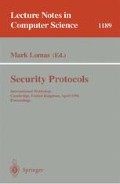Abstract
Key distribution is a major cryptographic component for secure communication. For privacy data must be encrypted with keys which are distributed securely. In this paper we focus on conference key distribution. Our approach is to use a two-party key distribution system as an underlying cryptographic primitive and extend it to a conference system.
We consider three different models: an unconditionally secure model, a provably secure model, and a model whose security is based on the difficulty of breaking the Diffie-Hellman problem. For each of these we present a conference key distribution system which is as secure as the primitive. These extend and generalize our conference scheme presented at Eurocrypt '94. In particular, (i) we are not restricted to any specific network or primitive and. (ii) our system based on the Diffie-Hellman key exchange is more efficient.
This paper is an improvement of the Eurocrypt '94 paper. The research on privacy was done while Mike Burmester visited Yvo Desmedt in April 1995, the part on authenticity in April and May 1996.
Supported in part by NSF Grant NCR-9106327.
Preview
Unable to display preview. Download preview PDF.
References
Bertsekas, D., Gallager, R.: Data networks. Prentice Hall (second edition), 1992.
Bellare, M., Rogaway, P.: Entity authentication and key distribution. In Advances in Cryptology — Crypto '93 (Lecture Notes in Computer Science 773) (1994) D. R. Stinson, Ed., Springer-Verlag, pp. 232–249.
Bird, R., Gopal, I., Herzberg, A., Jansen, P., Kutten, S., Molva, R., Yung, M.: Systematic design of two-party authentication protocols. In Advances in Cryptology — Crypto '91 (Lecture Notes in Computer Science 576) (1992) J. Feigenbaum, Ed., Springer-Verlag, pp. 44–61.
Burmester, M., Desmedt, Y.: A Secure and Efficient Conference Key Distribution System. In Advances in Cryptology — Eurocrypt '94 (Lecture Notes in Computer Science 950) (1995) A. De Santis, Ed., Springer-Verlag, pp. 275–286.
Diffie, W., Hellman, M.E.: New directions in cryptography. IEEE Trans. Inform. Theory, IT-22(6): 644–654, 1976.
Gibbons, A.: Algorithmic Graph Theory. Cambridge University Press, Cambridge, 1985.
Gilbert, E., MacWilliams, F., Sloane, N.: Codes which detect deception. The BELL System Technical Journal, 53(3): 405–424, 1974.
Goldreich, O., Goldwasser, S., Micali, S.: How to construct random functions. Journal of ACM, 33(4): 792–807, 1986.
Burmester, M., Desmedt, Y.: Efficient and Secure Conference Key Distribution. To be submitted. For an early version see: http://www.cs.uwm.edu/∼desmedt/CKDS.ps
Jueneman, R.: Analysis of certain aspects of output feedback mode. In Advances in Cryptology. Proc. Crypto 82 (1983) D. Chaum, R.L. Rivest, and A. T. Sherman, Eds., Plenum Press N. Y., pp. 99–127.
Kohl, J., Newmann, B.C.: The Kerberos network authentication service. MIT Project, Athena, Version 5.
Maurer, U.M.: Towards the equivalence of breaking the Diffie-Hellman protocol and computing the discrete logarithm. In Advances in Cryptology — Crypto '94 (Lecture Notes in Computer Science 839) (1994) Y. G. Desmedt, Ed., Springer-Verlag, pp. 271–281.
McCurley, K.S.: A key distribution system equivalent to factoring. Journal of Cryptology, 1(2): 95–105, 1988.
Rivest, R.L., Shamir, A., Adleman, L.: A method for obtaining digital signatures and public key cryptosystems. Commun. ACM, 21: 294–299, 1978.
Shannon, C.E.: Communication Theory of Secrecy Systems. Bell System Techn. Jour. 28: 656–715, 1949.
Schrift, A.W., Shamir, A.: The discrete log is very discreet. In Proceedings of the twenty second annual ACM Symp. Theory of Computing, STOC (1990) pp. 405–415.
U.S. Department of Commerce, National Bureau of Standards. Data Encryption Standard, January 1977. FIPS PUB 46 (NBS Federal Information Processing Standards Publ.).
Wegman, M.N., Carter, L.: New hash functions and their use in authentication and set equality. Journal of Computer and System Sciences, 22: 265–279, 1981.
Author information
Authors and Affiliations
Editor information
Rights and permissions
Copyright information
© 1997 Springer-Verlag Berlin Heidelberg
About this paper
Cite this paper
Burmester, M., Desmedt, Y.G. (1997). Efficient and secure conference-key distribution. In: Lomas, M. (eds) Security Protocols. Security Protocols 1996. Lecture Notes in Computer Science, vol 1189. Springer, Berlin, Heidelberg. https://doi.org/10.1007/3-540-62494-5_12
Download citation
DOI: https://doi.org/10.1007/3-540-62494-5_12
Published:
Publisher Name: Springer, Berlin, Heidelberg
Print ISBN: 978-3-540-62494-3
Online ISBN: 978-3-540-68047-5
eBook Packages: Springer Book Archive

